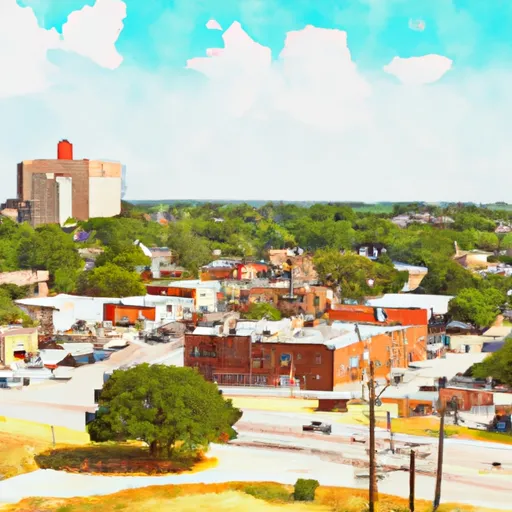-
 Snoflo Premium
Snoflo Premium
Get unlimited access to all our content
With no Ad interruptions! - Start Your Free Trial Login with existing account
Rhome
Eden Index
Climate
9.7
•
Recreation
3.5
•
Community
2.6
•
Safeguard
5.8/10

Rhome, Texas is a small city located in Wise County, in the northern part of the state. The climate in Rhome is characterized as humid subtropical, with hot summers and mild winters. Average high temperatures in the summer months can reach the mid-90s°F (35-36°C), while average lows in winter range from the mid-30s°F (1-2°C) to around 40°F (4°C).
In terms of hydrology constituents, Rhome is situated near several water bodies, including Lake Bridgeport and the West Fork Trinity River. These water sources offer opportunities for fishing, boating, and other water-based activities.
Rhome is surrounded by beautiful natural landscapes, providing ample outdoor recreation opportunities. The area features numerous parks, trails, and wildlife management areas that are ideal for hiking, biking, and birdwatching. Residents and visitors can enjoy activities such as camping, hunting, and nature photography in the nearby LBJ National Grasslands, which cover over 20,000 acres. The region's picturesque scenery and pleasant climate make Rhome an attractive destination for outdoor enthusiasts.
What is the Eden Index?
The Snoflo Eden Index serves as a comprehensive rating system for regions, evaluating their desirability through a holistic assessment of climate health, outdoor recreation opportunities, and natural disaster risk, acknowledging the profound impact of these factors on livability and well-being.
Climate Health Indicator (CHI): 9.7
Rhome receives approximately
916mm of rain per year,
with humidity levels near 78%
and air temperatures averaging around
18°C.
Rhome has a plant hardyness factor of
8, meaning
plants and agriculture in this region tend to thrive here all year round.
By considering the ideal temperature range, reliable water supplies, clean air, and stable seasonal rain or snowpacks, the Climate Health Indicator (CHI) underscores the significance of a healthy climate as the foundation for quality living.
A healthy climate is paramount for ensuring a high quality of life and livability in a region, fostering both physical well-being and environmental harmony. This can be characterized by ideal temperatures, reliable access to water supplies, clean air, and consistent seasonal rain or snowpacks.
Weather Forecast
Streamflow Conditions
Upper Trinity
Area Rivers
Upper Trinity
Snowpack Depths
Upper Trinity
Reservoir Storage Capacity
Upper Trinity
Groundwater Levels
Recreational Opportunity Index (ROI): 3.5
The Recreational Opportunity Index (ROI) recognizes the value of outdoor recreational options, such as parks, hiking trails, camping sites, and fishing spots, while acknowledging that climate plays a pivotal role in ensuring the comfort and consistency of these experiences.
Access to outdoor recreational opportunities, encompassing activities such as parks, hiking, camping, and fishing, is crucial for overall well-being, and the climate plays a pivotal role in enabling and enhancing these experiences, ensuring that individuals can engage in nature-based activities comfortably and consistently.
Camping Areas
| Campground | Campsites | Reservations | Toilets | Showers | Elevation |
|---|---|---|---|---|---|
| Boone Park - Lake Nocona | None | 844 ft | |||
| Joe Benton Park - Lake Nocona | None | 852 ft | |||
| Mountain Lake | None | 1,002 ft | |||
| Black Creek Lake | 24 | 947 ft | |||
| Weldon Rob Memorial Park - Lake Nocona | 20 | 864 ft | |||
| Fuqua Lake | None | 1,117 ft | |||
| Healdton Municipal Lake | 57 | 900 ft | |||
| Tadra Point | 23 | 918 ft |
Nearby Ski Areas
Catastrophe Safeguard Index (CSI):
The Catastrophe Safeguard Index (CSI) recognizes that natural disaster risk, encompassing floods, fires, hurricanes, and tornadoes, can drastically affect safety and the overall appeal of an area.
The level of natural disaster risk in a region significantly affects safety and the overall livability, with climate change amplifying these risks by potentially increasing the frequency and intensity of events like floods, fires, hurricanes, and tornadoes, thereby posing substantial challenges to community resilience and well-being.
Community Resilience Indicator (CRI): 2.6
The Community Resilience Indicator (CRI) recognizes that education, healthcare, and socioeconomics are crucial to the well-being of a region. The CRI acknowledges the profound impact of these elements on residents' overall quality of life. By evaluating educational resources, healthcare accessibility, and economic inclusivity, the index captures the essential aspects that contribute to a thriving community, fostering resident satisfaction, equity, and social cohesion.

